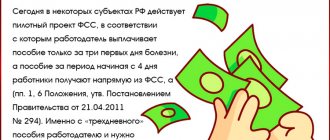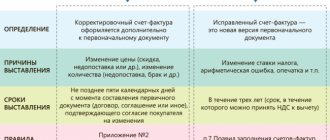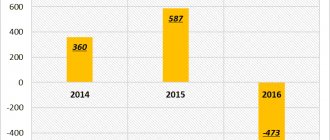Each organization must have its own capital, which consists of investments from members and founders, as well as loans from partner organizations or reserve funds in bank accounts. And if the total amount of money borrowed exceeds the funds invested, then the capital is negative, which is bad for the business relationship because few partners will want to enter into transactions with an organization that has negative capital. The surest way to increase your own capital and turn it into a positive one is to make a contribution to the company's general funds in the form of retained earnings that were generated during the reporting period.
Concept of capital and reserves
Capital should be understood as the sum of the enterprise's own and borrowed funds.
Equity is the monetary value of a company's assets that are owned by it.
Capital and reserves in the balance sheet is an information block that consists of 7 lines.
When calculating equity capital, the difference between the value of all property on the balance sheet (the company's assets) and the company's liabilities is obtained.
Any financial and economic activity requires constant investment of capital. Investments are required to maintain and expand the production process and improve its efficiency and introduce innovation. One of the main tasks of financial management is the development of the investment budget, support and optimization of investments to attract financial resources, and optimization of the capital structure.
The choice of sources of financing is influenced by various factors, including the industry and scale of the enterprise’s activities, technological features of the production process, specifications of products, work with banking structures, reputation in the market, etc.
The structure of the “Capital and Reserves” section of the balance sheet used by the enterprise is determined by all financial assets that have an active impact on the final result of the company’s activities. It affects the profitability of assets and funds, forms the ratio of profit and risk in the process of enterprise development.
The financial structure of capital and reserves on the balance sheet is the structure of the main sources of funds, i.e. the ratio of equity and debt capital.
The financial capital of an enterprise consists of its own and borrowed capital.
The balance sheet item “Capital and reserves” in the form of equity capital consists of the value of authorized, reserve and additional capital. In addition, it includes the value of retained earnings received from the operation of the enterprise. Debt capital is an enterprise's accounts payable to individuals and legal entities, including banks.
Provisions are an estimate and explanation of individual items in a business's accounting records aimed at covering expenses and payments due.
What are the features of accounting for a small enterprise?
Accounting at enterprises classified as small businesses may differ significantly from the corresponding procedures that characterize the activities of medium and large companies. First of all, it is worth considering the criteria for classifying an economic entity as a small enterprise. This includes the following company:
- in which the authorized capital is more than 25% private;
- which employs from 15 to 100 people, and the annual revenue is 120-800 million rubles (if the business entity has a smaller staff and turnover, then it will be classified as a micro-enterprise).
The main feature of accounting for a small enterprise is the ability to conduct it in a simplified format. It differs significantly from the general accounting scheme, which involves:
- filling out a balance sheet, financial statements, as well as various applications that complement them;
- drawing up an audit report in cases provided for by law;
- drawing up an explanatory note to the balance sheet and financial results report.
Among the main sections of the financial statements are “Capital and reserves” in the balance sheet. This is an information block reflecting financial indicators that are the most important from the point of view of assessing the economic efficiency of the company. The general procedure for maintaining accounting requires its mandatory completion. The simplified version also involves filling out the “Capital and Reserves” section in the balance sheet. This is a mandatory component of reporting for commercial firms, despite the fact that the simplified accounting procedure is characterized by a number of significant preferences for small businesses. Namely:
- the ability not to draw up supplements to the balance sheet and an explanatory note to it (if there is no objective need for this);
- the ability not to include in reporting documents figures on business results within groups of items (that is, there is no legal requirement to indicate indicators for specific items).
As for accounting itself, a small enterprise can conduct it either in a simple form, without registers, or in a standard form. At the same time, a company that has the appropriate status and enjoys statutory preferences for simplified accounting must keep in mind that the recording of business transactions must meet the criterion of rationality. Experts recommend following a similar rule when preparing reports.
Thus, it makes sense, if possible, to specify the indicators for individual items within the “Capital and Reserves” section in the balance sheet of a small enterprise. Let's take a closer look at how the corresponding reporting area can be filled out.
Differences between equity capital and debt capital
Own and borrowed capital can be distinguished from each other by a number of characteristics. Own capital (and reserves on the balance sheet) are funds that are characterized by the characteristics shown in the table.
| Sign | Equity | Borrowed capital |
| Right to participate in management | Eat | No |
| Risk attitude | Reducing financial risk by increasing share | Increase in risk with increasing share |
| Opportunity to make a profit | Based on the remainder principle | First of all |
| The order of satisfaction of creditors' claims | Based on the remainder principle | First of all |
| Terms of payment and return | Not installed | In the loan agreement |
| Direction of financing | Long-term assets | Current assets |
| Possibility of tax reduction | No | Eat |
| Sources of financing | Internal and external | External |
| The relationship between owner income and firm performance | Direct link to firm results | No connection |
World practice shows that the cheapest source is debt financing, since creditors are in a more privileged position compared to the owners of the enterprise. They reserve the right to recover their investment, and in the event of bankruptcy, their claims will be satisfied before those of the shareholders. Nevertheless, an uncontrolled increase in debt financing can significantly reduce the financial stability of an enterprise, lead to a fall in the market price of its shares, and in the event of unfavorable events, put the enterprise at risk of bankruptcy.
Categories
Today we will focus on the items capital and reserves of an enterprise as part of accounting.
These are items related to the company's liabilities, that is, they show where the money in the company came from. So in our case, we see that money comes to the company from the capital and reserves of the enterprise.
Looking at the balance sheet items, which I have already shown in a separate article “Composition of the Balance Sheet”, we see that the capital and reserves of the enterprise include:
- authorized capital
- retained earnings
- reserves
- shares repurchased from shareholders
Equity capital is the funds invested by the founders when forming the company. In the future it may be increased by additional issues of shares. Consequently, the item for replenishing the company’s capital is the funds of the shareholders, that is, you and me. Unlike long-term and short-term liabilities of an enterprise, capital is not borrowed money and there are no obligations for payment in the future. It is believed that the authorized capital is never returned to the founders. In fact, it can only be returned upon closure of the company.
But here we must not forget that, unlike the company’s creditors, the owners have the right to all profits, and not a certain pre-agreed percentage.
Shareholders' equity includes both ordinary and preferred shares. If ordinary shares give the right to participate in the management of the company (the right to vote at a meeting of shareholders), then preferred shares give privileges in the distribution of profits.
Typically, the company's charter specifies the share of profits that will be paid out in the form of dividends to holders of preferred shares. Although in our stock market there are cases when, instead of a percentage of profit, a specific amount is prescribed, paid in the form of dividends, which in turn turns such preferred shares practically into bonds.
Please note that the special rights that preferred shares give do not mean their higher status compared to ordinary shares. Quite the contrary. Owners of preferred shares do not have voting rights at shareholders' meetings. They receive voting rights only if preferred shares are equal to ordinary shares. This happens either if the charter stipulates the conversion of preferred shares into ordinary shares after some time, or if the company does not pay the share of profits guaranteed by the charter in the form of dividends.
Based on the above, you need to know that if preferred shares are redeemed after a certain time, then for accounting it is no longer shares, but long-term debt of the companies. Consequently, they should not be included in the capital item, but they must be reflected precisely as long-term debt.
The capital also includes so-called treasury shares. These are shares purchased by the company itself from shareholders. They reduce the company's capital, that is, they are indicated with a minus sign on the balance sheet. I will focus on Treasury stocks in a separate article. Their properties are very interesting for us as shareholders.
The article “capital and reserves of the enterprise” also includes retained earnings. All profits earned by the company that were not issued in the form of dividends and were not reinvested in production are accumulated here. If the company suffers losses for several years, instead of retained earnings, an uncovered loss may accumulate here.
And lastly, reserves. This includes those operations to change the company's assets that, for one reason or another, are not reflected in the income statement.
• reserve for positive revaluation of fixed assets • reserve for changes in the market value of securities available for sale • reserve for actuarial gains/losses (pension programs) • reserve for accumulated exchange rate differences.
Such transactions are published in a separate report - the statement of changes in equity. So we will consider them separately when analyzing this report.
In conclusion, I would like to say that it is not uncommon for the entire section “capital and reserves of an enterprise” to appear with a minus sign. This happens especially often in the first years of a company’s life, when expenses are quite high (especially on fixed assets), and profits have not yet appeared. In this case, losses accumulate in the “Uncovered loss” item. You should look at the shares of such companies very carefully before you decide to buy them. Perhaps the company is just beginning to develop and that is why it has high expenses, or it is possible that with a change in economic conditions the entire business has become unprofitable and you should not buy its shares even at a very low price.
Similar
How is it reflected in the balance sheet?
The “Capital and Reserves” section of the balance sheet reflects the company’s own sources of financing. This section includes the items below.
| Index | Line code |
| Authorized capital | 1310 |
| Own shares | 1320 |
| Revaluation of fixed assets | 1340 |
| Extra capital | 1350 |
| Reserve capital | 1360 |
| retained earnings | 1370 |
If a company uses simplified reporting, then the amount of capital and reserves on the balance sheet is a single line, reflected in one amount without breakdown.
What are financial statements?
First, a little theory about accounting. Facts about it will be useful for us from the point of view of understanding the tasks facing the financial services of any commercial company.
We noted above that financial statements should be prepared by enterprises with the status of legal entities. This is an important nuance, since individual entrepreneurs, who, from the point of view of the legislation of the Russian Federation, are individuals, should not keep accounting records, nor should they fill out reports based on the corresponding registers. The obligations of the individual entrepreneur in terms of financial accounting are limited to maintaining the Book of Income and Expenses.
The financial statements of a legal entity are usually understood as a set of information that reflects the results of the enterprise’s economic activities within the reporting period. This information is formed primarily through indicators recorded in accounting registers.
The type of reporting under consideration is one of the key ones in the enterprise, along with tax and management. The information reflected in it is used to assess the financial condition of the company, its growth prospects, the correctness of significant indicators of economic activity, as well as tax reporting. This information may be of interest to managers, company owners, and government agencies.
Accounting statements play an important role in the interaction of an enterprise with potential creditors and investors. Persons interested in investing in a company will strive to consider reliable sources that allow them to adequately assess the financial condition of the enterprise. Among those that fully satisfy these criteria are financial statements. It is compiled and certified by competent employees of the company, sometimes with the involvement of external independent consultants who are able to analyze how correctly this or that section of the balance sheet is filled out (“Capital and reserves,” for example), and what points can be improved in the reporting procedure used .
The advantage of the sources under consideration is their regularity. Accounting statements can be prepared once a year or more often, depending on legal requirements, as well as the wishes of stakeholders, such as owners and creditors. Accounting statements, as a rule, are prepared according to standard forms that are approved by regulatory authorities - primarily the Ministry of Finance of the Russian Federation. It reflects a variety of economic indicators: assets, liabilities of the balance sheet, capital and reserves of the company.
Accounting statements must correlate with primary sources, as well as registers that are used by the financial services of the enterprise. The most important task of this type of reporting is to identify significant facts that reflect the financial stability of the company, the presence of certain reserves, and the dynamics of income and expenses.
How is it filled out?
The table reflects the basic data on the composition and methods of calculating the indicators of the studied section of the balance sheet.
| Index | Line code | Using account data | Calculation method |
| Authorized capital | 1310 | 80 | K80 |
| Own shares | 1320 | 81 | D81 |
| Revaluation of fixed assets | 1340 | 83 “Additional capital” | K83 (amount of additional valuation) |
| Extra capital | 1350 | 83 | K83 (without revaluation amount) |
| Reserve capital | 1360 | 82 “Reserve capital” | K82 |
| retained earnings | 1370 | 99 “profits and losses”, 84 “Retained earnings” | K99 + K84, D99 + D84, K84 - D99, K99 - D84 |
Information can be reflected as of the reporting date, as of December 31 of the previous year and as of December 31 of the previous year.
Explanation of the balance sheet according to the lines of section 4
In the current balance sheet form, the assets are allocated lines from 1100 to 1600. Let's start with deciphering the balance sheet lines of the 1st section “Non-current assets”, where it is accumulated, incl. information about the presence of assets with low liquidity in the company - fixed assets (fixed assets) and intangible assets (intangible assets). The lines of this section record their residual value, i.e. the difference between the original price and accrued depreciation.
| Balance sheet line | Decoding | How is the balance formed and from what accounts is it taken? | |
| Name | code | ||
| Intangible assets (IMA) | 1110 | The residual value of intangible assets (patents, licenses, software) is the difference between the debit balance of the account. 04 and the balance on the loan account. 05 | D/t 04 (not taking into account R&D) – K/t 05, or D/t 04, if the account is not applied. 05, and depreciation is taken into account on the account. 04 |
| Research and development results | 1120 | The company's expenses on completed and positive results, but not related to intangible assets, scientific developments (R&D) are taken into account in separate sub-accounts to the account. 04 | D/t 04 for R&D expenses |
| Intangible search assets (IPA) | 1130 | Costs for searching and evaluating mineral deposits - the right to conduct exploration, collecting information about the subsoil, the results of exploration drilling, the cost of assessing the feasibility of development. Accounted for as part of capital investments, indicated in the balance sheet minus accrued depreciation | D/t 08 – K/t 05 for related to search intangible assets |
| Material prospecting assets (MPAs) | 1140 | Material component of search and exploration costs | D/t 08- K/t 02 in terms of MPA |
| Fixed Assets (Fixed Assets) | 1150 | The residual value of fixed assets (buildings, equipment, tools, machines) is the debit balance of the account. 01, reduced by the amount of accrued depreciation on the fixed assets, i.e. on the credit balance of the account. 02. On line 1150 of the balance sheet, the explanation (example) could be as follows: if for an OS object with an initial cost of 100 thousand rubles. depreciation in the amount of 20 thousand rubles is accrued, then in the balance sheet its value will be 80 thousand rubles. (100 – 20) | D/t 01 – K/t 02 (except for wear and tear on fixed assets taken into account on account 03) |
| Profitable investments in material assets | 1160 | The residual value of assets, for example, equipment, listed on the account. 03 and intended for rental/rental | D/t 03 – K/t 02 in terms of depreciation accrued on the property recorded on the account. 03 |
| Financial investments | 1170 | Information about the company's investments to make a profit. Debit balance on long-term investment accounts: — loans to personnel (account 73/1), - for deposit accounts (account 55/3) and financial investment account 58. If a reserve was created for the depreciation of investments (account 59), then the balance in account. 58 is reduced by the credit balance on the account. 59 | D/t 55/3 D/t 58 – K/t 59 (when creating a reserve) D/t 73/1 for long-term interest-bearing loans |
| Deferred tax assets (DTA) | 1180 | Formed if tax accounting does not coincide with accounting, it reduces the amount of income tax. | D/t 09 |
| Other noncurrent assets | 1190 | Line 1190 of the balance sheet (decoding): indicates property the value of which is recognized as insignificant, for example, uninstalled equipment, capital investments or expenses that the company will incur outside the reporting period - account. 07, 08, 97 (regarding a one-time payment for the right to use an intellectual resource) | D/t 07 D/t 08 (except for those related to exploration assets) D/t 97 (for expenses with a write-off period of more than a year) |
| Total for Section I | 1100 | Total line by section | Sum of filled section lines |
| Balance sheet line | Decoding | How is the balance formed and from what accounts is it taken? | |
| Name | code | ||
| Reserves | 1210 | Explanation of line 1210 “Inventories” in the balance sheet includes:
| D/t 10 D/t 15 D/t 16 (or – K/t 16) D/t 20 D/t 21 D/t 23 D/t 28 D/t 29 D/t 41 D/t 43 – K /t 42– K/t 14 D/t 44 D/t 45 |
| VAT on purchased assets | 1220 | Debit balance of the account. 19 “VAT on purchased MC” | D/t 19 |
| Accounts receivable | 1230 | Combine debit balances on settlement accounts with suppliers, customers, employees - 60, 62, 70, 71, 73 (excluding long-term interest-bearing loans on account 73/1), 75, 68, 69.76 (VAT on advances reflected on these are not taken into account). The credit balance of the account is subtracted from the resulting value. 63 “Reserves for doubtful debts”, if a reserve was created | D/t 60 D/t 62 – K/t 63 D/t 68 D/t 69 D/t 70 D/t 71 D/t 73 (except for loans on account 73-1) D/t 75 D/t 76 (less VAT on advances issued and received) |
| Financial investments (except cash equivalents) | 1240 | Investments in short-term periods (less than a year) to make a profit. Sum up the debit balances on accounts 55/3 and 58 (minus the credit balance of the reserve for impairment of short-term investments on account 59), 73 | D/t 58 – K/t 59 D/t 55/3 D/t 73-1 (for short-term transactions) |
| Cash and cash equivalents | 1250 | They generate information about the balances of funds in bank accounts and the cash desk of the company, for which they sum up the debit balances on accounts 50 (except for the subaccount for monetary documents 50/3), 51, 52, 55, 57, 58 (in terms of cash equivalents - securities , shares, etc.) | D/t 50 (except 50/3) D/t 51 D/t 52 D/t 55 (except 55/3) D/t 57 D/t 58 (for investments in securities) |
| Other current assets | 1260 | The value of assets not included in the listed lines, for example, the debit balance of an account. 50/3 (when taking into account monetary documents), the amount of shortages and losses in the account. 94 | D/t 50/3 D/t 94 |
| Total for Section II | 1200 | Total line by section | Sum of filled section lines |
| BALANCE | 1600 | Total for balance sheet assets | Sum of lines 1100 and 1200 |
We invite you to read: Is it possible to buy a dacha with maternity capital in 2021: a dacha house with a plot of land in SNT with or without registration
| Balance sheet line | Decoding | How is the balance formed and from what accounts is it taken? | |
| Name | code | ||
| UK | 1310 | Amount of authorized capital | K/t 80 |
| Own shares purchased from shareholders | 1320 | This is a negative indicator on the balance sheet (indicated in parentheses), indicating the balance of the company's shares, which it bought back from participants for intended resale or cancellation | D/t 81 |
| Revaluation of non-current assets | 1340 | The amount of additional valuation of fixed assets and intangible assets resulting from revaluation (revision of the initial value of property), recorded in the account. 83 | K/t 83 (in terms of additional valuation of fixed assets and intangible assets) |
| Additional capital (without revaluation) | 1350 | The amount of additional capital without taking into account the revaluation carried out, for example, upon receipt of property - the credit balance on the account. 83 | K/t 83 (except for revaluation amounts) |
| Reserve capital | 1360 | The amount of the formed reserve fund or other funds formed by distribution from the company’s profits is the credit balance of the account. 82 | K/t 82 |
| Retained earnings/uncovered loss | 1370 | Balance sheet line 1370 - decoding reflects the result of the enterprise's activities: the amount of profit remaining in the company after taxes or the amount of loss. A credit balance means the presence of retained earnings, a debit balance means a loss. | One way:
|
| Total for Section III | 1300 | Total line by section | Sum of section row indicators |
| Balance sheet line | Decoding | How is the balance formed and from what accounts is it taken? | |
| Name | code | ||
| Borrowed funds | 1410 | Balance of outstanding long-term loan taken out for a period of more than 12 months | K/t 67 |
| Deferred tax liabilities (DTL) | 1420 | Formed if tax accounting in a company differs from accounting - the differences are formed according to the account. 77, the balance of outstanding obligations is the credit balance on the account. 77 | K/t 77 |
| Estimated liabilities | 1430 | The amount of reserves for upcoming expenses planned in the long term, for example, for reconstruction - the credit balance on the account. 96 | K/t 96 in terms of reserves formed for events that will occur no earlier than in a year |
| Other obligations | 1450 | Reflect borrowed (not own!) funds that are not indicated in line 1410. This may be long-term debt to a counterparty or the budget, incl. on bills of exchange, target receipts with a long-term perspective of coverage | K/t 60 K/t 62 K/t 68 K/t 69 K/t 76 K/t 86 (for long-term debt) |
| Total for Section IV | 1400 | Total line | Sum of partition rows |
| Balance sheet line | Decoding | How is the balance formed and from what accounts is it taken? | |
| Name | code | ||
| Borrowed funds | 1510 | Balance of outstanding short-term loans provided by banks or other companies | K/t 66 |
| Accounts payable | 1520 | For balance line 1520, the breakdown includes debt balances (credit balances), the repayment period of which is no more than 12 months, to various counterparties: — suppliers (account 60), customers (account 62); — founders (account 75); — different debtors/creditors (account 76); — personnel for salaries (account 70), reporting (account 71), other operations (account 73); — budget (account 68) and funds (account 69) | K/t 60 K/t 62 K/t 68 K/t 69 K/t 70 K/t 71 K/t 73 K/t 75 K/t 76 (for short-term debts minus VAT appearing on the accounts on issued/ advances received) |
| revenue of the future periods | 1530 | A credit balance against deferred income, for example when a company has received several months' rent in advance. | K/t 98 |
| Estimated liabilities | 1540 | The amount of reserves for future expenses in short-term periods (less than 12 months), for example, for the payment of vacation pay - the credit balance of the account. 96 | K/t 96 |
| Other obligations | 1550 | Other obligations not included in the listed lines, for example, the balance of target funds on the account. 86 | K/t 86 regarding short-term debt with a maturity of less than 12 months |
| Total for Section V | 1500 | Total line | Sum of rows by section |
| BALANCE | 1700 | Total balance sheet liabilities | 1300 1400 1500 |
Authorized capital
In the balance sheet, “Capital and reserves” is represented by the authorized capital.
Authorized capital is understood as the amount of contributions of the founders to the development of the company at the very beginning of its formation. The minimum amount of this capital is determined by law and is individual for each open pension fund. There is no maximum size limit. The size of the company's authorized capital is clearly stated in the company's constituent documents when it is registered with the tax authority.
Own shares
Companies can record on this line the shares of participants acquired by the company for the purpose of transferring to other persons.
Own shares transferred to the company in the reporting year, for which the participant must pay its actual value in accordance with the financial statements for the reporting year, are reflected in the financial statements at par value.
Authorized capital in the balance sheet: line 1310
— increased by the amount of additional capital from the revaluation of fixed assets and intangible assets retired in the reporting period (clause 15 of PBU 6/01, clause 21 of PBU 14/2007);
— adjusted by the amount of increase in the authorized capital due to retained earnings (reduction of the authorized capital when it is brought to the value of net assets);
— reduced by the amount of accrued interim dividends.
NOTE!
If the organization does not have retained earnings (uncovered loss) from previous years and during the reporting period interim dividends were not distributed and previously overvalued fixed assets were not disposed of, then the value of line 1370 as of the reporting date should coincide with the value of line 2400 “Net profit (loss) of the reporting period » financial results report.
If the organization identified, after approving the financial statements for the reporting year, significant errors from the previous reporting year and were corrected by entries in the corresponding accounting accounts in the current reporting period, then the indicator of line 1370 of the balance sheet for the reporting period in which the corrective entries were made will differ from the indicator of line 1370 of the balance sheet for the reporting period in which the corrective entries were made. 2400 “Net profit (loss) of the reporting period” of the income statement for this reporting period.
If an organization pays interim dividends during the reporting year, these dividends, as recommended by the Ministry of Finance of the Russian Federation in letter dated December 19, 2006 N 07-05-06/302, should be reflected separately in Section III “Capital and Reserves” of the balance sheet (in parentheses ). For this, the organization will need to provide a separate line, for example line 1371 “including interim dividends”.
Extra capital
This type of capital reflects the cost of the organization’s additional capital, excluding the amounts of revaluation of fixed assets.
Additional capital is formed from the following elements:
- share premium, received as the difference between the sale price and the par value of the share;
- difference in exchange rates associated with payments to founders by deposits;
- the difference arising as a result of the translation of the price of the company's assets and liabilities used to conduct business outside the Russian Federation from rubles to foreign currency;
- contributions to company property;
- VAT reimbursed by the founder when transferring property as a contribution.
Own shares in the balance sheet: line 1320
This line shows the amount of increase in the value of non-current assets, identified based on the results of their revaluation, accounted for separately on account 83 “Additional capital” (Instructions for using the Chart of Accounts, paragraph 15 of the Accounting Regulations “Accounting for Fixed Assets” PBU 6/01, approved by the Order Ministry of Finance of the Russian Federation dated March 30, 2001 N 26n (hereinafter referred to as PBU 6/01), paragraph 21 of the Accounting Regulations “Accounting for Intangible Assets” (hereinafter referred to as PBU 14/2007), approved by Order of the Ministry of Finance of the Russian Federation dated December 27, 2007 N 153n (hereinafter referred to as PBU 14/2007)).
When filling out line 1340, data on the credit balance in account 83 “Additional capital” is used, analytical accounts for accounting for the amounts of additional valuation of fixed assets and intangible assets as of the reporting date.
Let us recall that the revaluation of fixed assets and intangible assets is carried out at the end of the reporting year (paragraph 1 of paragraph 15 of PBU 6/01, paragraph 17 of PBU 14/2007).
This line reflects the amount of additional capital of the organization, recorded in account 83 “Additional capital”, with the exception of the amounts of additional valuation of non-current assets.
https://www.youtube.com/watch?v=https:accounts.google.comServiceLogin
When filling out line 1350, data on the credit balance in account 83 “Additional capital” (except for the amounts of additional valuation of non-current assets) as of the reporting date is used.
— contributions to the property of a limited liability company (Article 27 of the Federal Law of February 8, 1998 N 14-FZ “On Limited Liability Companies”, letter of the Ministry of Finance of the Russian Federation dated April 13, 2005 N 07-05-06/107);
- amounts received in excess of the par value of the issued shares (share premium of the joint-stock company) (clause 68 of Regulation No. 34n);
— exchange rate differences associated with settlements with founders on deposits, including contributions to the authorized (share) capital of an organization, expressed in foreign currency (clause 14 of the Accounting Regulations “Accounting for assets and liabilities, the value of which is expressed in foreign currency” (PBU 3/2006), approved by Order of the Ministry of Finance of the Russian Federation dated November 27, 2006 N 154n (hereinafter referred to as PBU 3/2006));
— the difference arising as a result of the recalculation of the value of the assets and liabilities of the organization, expressed in foreign currency, used to conduct activities outside the Russian Federation, into rubles (clause 19 of PBU 3/2006).
This line shows the amount of the organization’s reserve capital, formed both in accordance with the constituent documents and in accordance with the legislation of the Russian Federation (clause 69 of Regulation No. 34n).
When filling out line 1360, data on the credit balance of account 82 “Reserve capital” and account 84 “Retained earnings (uncovered loss)” (in terms of special funds, with the exception of funds for financing current expenses) as of the reporting date is used.
NOTE!
An organization has the right to create accounting for its special funds, for example, for the payment of dividends on preferred shares, for the corporatization of employees in account 84 “Retained earnings (uncovered loss)” separately (Instructions for using the Chart of Accounts). However, regardless of the account in which these funds are accounted for, they are reflected in the balance sheet on line 1360.
— reserve fund (clause 1 of Article 35 of Federal Law No. 208-FZ of December 26, 1995 “On Joint-Stock Companies” (hereinafter referred to as Federal Law No. 208-FZ));
— a special fund for the corporatization of employees (clause 2 of Article 35 of Federal Law N 208-FZ);
https://www.youtube.com/watch?v=ytcopyrightru
— special funds for paying dividends on preferred shares of certain types (clause 2 of Article 42 of Federal Law N 208-FZ) and so on.
— reserve fund;
- other funds created in the manner and amounts established by the company’s charter.
- a reserve fund created in the manner and in the amounts provided for by the charter of a unitary enterprise (clause 1 of Article 16 of Federal Law No. 161-FZ of November 14, 2002 “On State and Municipal Unitary Enterprises” (hereinafter referred to as Federal Law No. 161-FZ) ;
- other funds provided for by the charter of a unitary enterprise (clause 2 of Article 16 of Federal Law No. 161-FZ).
So, the organization’s property exists in the form of non-current and current assets. The balance sheet assets have two sections: I “Non-current assets” and II “Current assets”.
The balance sheet assets are built in order of increasing liquidity: first, less liquid items are listed, and then more liquid items. The “Non-current assets” section discloses data on intangible assets, fixed assets, construction in progress, profitable investments in tangible assets, long-term financial investments, deferred tax assets, and other non-current assets.
The “Current assets” section reflects data on the organization’s current assets: enterprise inventories, VAT on purchased assets, accounts receivable (payments for which are expected more than 12 months after the reporting date), accounts receivable (payments for which are expected within 12 months after the reporting date). dates), short-term financial investments, cash, other current assets.
Reserve capital
Reserve capital can be formed without fail in accordance with the law, which applies to joint stock companies. A limited liability company can form this capital voluntarily in accordance with the charter.
The reserve fund of a joint stock company is intended for the following purposes:
- cover losses;
- buy the company's bonds;
- to buy back shares.
How and for what purposes is reserve capital created?
When mentioning the need to create reserve funds in the organization, their volume is increased from funds that remain free at the end of the year. The main source of their income is the profit of the enterprise. Reserve capital funds are intended to quickly cover losses incurred by the organization, repay the cost of bonds and implement measures to repurchase shares. Such target predetermination is typical for joint stock companies. In the case of an LLC, the enterprise's reserve capital can be used for:
- covering the amount of losses if at the end of the reporting period it was not possible to reach the break-even point;
- redemption of bond securities;
- redemption of individual shares;
- other purposes provided for by the Charter (this is not possible for a JSC).
Reserve capital is included in the equity capital of institutions. It must comply with the legally established volume. Its amount is indicated in the statutory documentation. Reserve capital is created through annual contributions, which are mandatory. Law No. 208-FZ stipulates that the amount of regular contributions cannot be less than the limit established by the legislator. For joint-stock companies, there is a rule on a minimum contribution rate equal to 5% of net profit. The norm remains relevant until the total amount of capital prescribed in the Charter is reached.
The formation of reserve capital should occur after the set of financial statements has been approved. It is necessary to adhere to this setting in order to derive the value of retained earnings and develop a scheme for directing it to different sectors of activity. The amount of reserve capital cannot be less than the legally approved limit. For JSC there is a restriction in the form of comparing the amount of the authorized capital with the reserve capital. The latter must be brought to the level of 5% of the authorized capital (or more).
Relationships between balance sheet assets, capital and liabilities of the company
A company's assets are understood as part of the balance sheet, which reflects the composition and value of the company's assets as of a specified date. We can say that these are resources controlled by the company based on the results of past events, from which the company expects economic benefits in the future. An asset can lead to possible future economic benefits when the company's potential is applied.
The company's liabilities are understood as the company's debt as of a specific date, which reflects the amount of the company's expenses leading to an outflow of capital. Obligations may arise against the background of concluded agreements between the company and its counterparties. Liabilities are distributed by maturity into long-term (line 1400) and short-term (line 1500).
The balance sheet asset, capital, reserves and liabilities of the company have the following interdependence:
K = A – O,
where K is the capital of the company, t.r.
A – assets, t.r.
O – obligations of the company, t.r.








